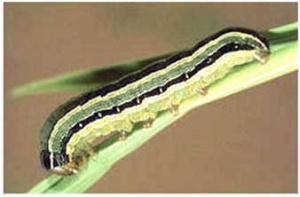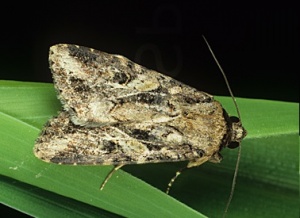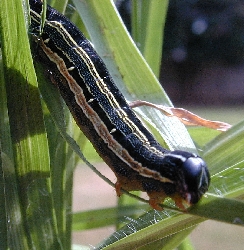Difference between revisions of "Armyworm"
| Line 1: | Line 1: | ||
African Armyworm - Spodoptera exempta | African Armyworm - Spodoptera exempta | ||
| + | [[Image:moth.jpg|thumb|centre| [http://dwpicture.com.au/picture.asp?picture=108221 © copyright of The DW Stock Picture Library]]] | ||
[[Image:Spodoptera_exempta.jpg|thumb|left| [http://blog.plantwise.org/2012/12/14/armyworms-devastate-crops-in-zambia-threatening-food-security/armyworm/]]] | [[Image:Spodoptera_exempta.jpg|thumb|left| [http://blog.plantwise.org/2012/12/14/armyworms-devastate-crops-in-zambia-threatening-food-security/armyworm/]]] | ||
[[Image:Spodoptera_exempta_3.jpg|thumb|right| final stage @ low density [http://www.ljmu.ac.uk/NSP/98748.htm]]] | [[Image:Spodoptera_exempta_3.jpg|thumb|right| final stage @ low density [http://www.ljmu.ac.uk/NSP/98748.htm]]] | ||
Revision as of 20:17, 11 August 2014
African Armyworm - Spodoptera exempta


The African Armyworm is also called okalombo, Kommandowurm or nutgrass armyworm. It is the larval stage of a moth. The larvae feed on all types of grasses and early stages of grains. It does well on wet conditions and do not proliferate in dry conditions. The moths live about 10 days. One female maximally lays 1000 eggs in total. The eggs are laid in clusters on leaves, and hatch in 2–5 days.
At high density the caterpillars are black with yellow stripes. At low density, they are green or brown. They turn black when they are 10 days old.
Temperature dominantly affects larval and pupal development time, larval and pupal survivorship and pupal weight. The higher the temperature (34°C, 28°C or 22°C), the faster they grow. They als grow faster (and bigger) on well watered plants (80-90% moisture content) vs water stressed plants (60-70% MC) Survivorship in larval and pupal stage is generally lower at 22°C, and on water stressed plants in very young and older larvae. Larvae reared at high temperature exhibit lighter coloration.[5]


